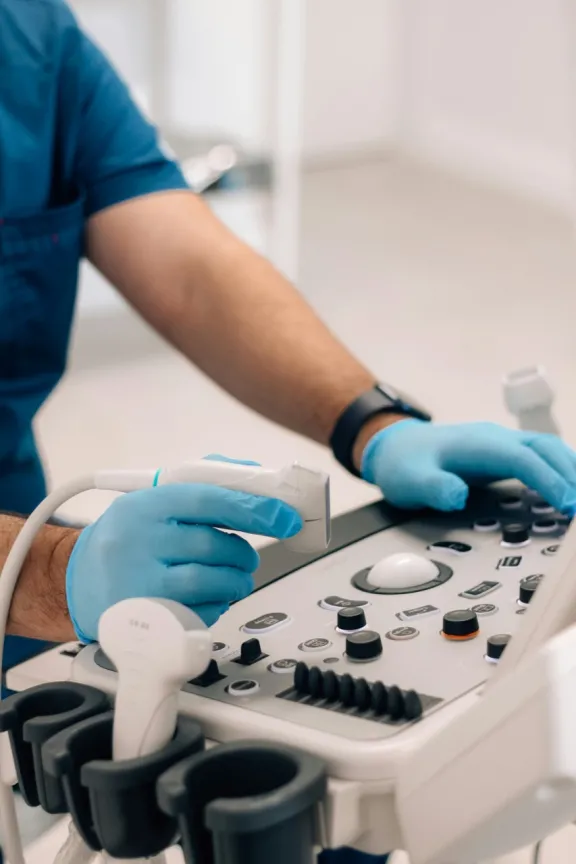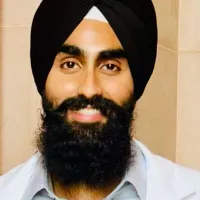
A Bedside Revolution: POCUS Training at UCSF
In the quiet uncertainty of an emergency department, a woman in gut-wrenching pain arrives, unable to catch a breath. Within a matter of minutes, Dr. Sally Graglia completes a point-of-care ultrasound (POCUS), confirming her concern of ovarian torsion — an excruciating medical emergency where an ovary or fallopian tube twists on the tissues supporting it.
Two doors down the hall, a trauma patient clutching their dislocated shoulder hobbles in; before the X-ray team arrives, the shoulder is put back into place and verified through POCUS. These stories are not confined to a single hospital in UCSF or San Francisco but across the entire country.
POCUS has become a portable innovation across different corners of medicine — a tool valued for not only its bedside significance but also its diagnostic precision and immediacy. Like the stethoscope revolutionized medicine two centuries ago, POCUS has emerged as a transformative diagnostic tool, expediting treatment in trauma care and minimizing radiation exposure. The increasing use of POCUS, which was initially reserved for residency education, has begun to find a role in undergraduate medical education.
And, the integration of POCUS into undergraduate medical education has been advancing here at UCSF.
POCUS Elective
Just remember, steady hands...drop the pinkie...knuckles to the bed.
In the depths of a fluorescently lit basement room of UCSF’s main hospital, Graglia leads a reflective round-robin of first-year and second year medical students as they wrap up their final POCUS elective session.
“If there is one thing you absolutely need to remember, this is it. Repeat after me, I solemnly swear to do an aorta study every time I do a renal US,” said Graglia. “Oh, and I won’t forget to plug in the machine.”
Graglia is Associate Clinical Professor and Director of Medical Student Ultrasound Education within the Department of Emergency Medicine at UCSF, and an emergency medicine physician with a fellowship training in POCUS.
After assuming the role of director in 2018, she took charge of the POCUS elective and has since dedicated herself to integrating POCUS training into UCSF's medical education curriculum. The POCUS elective is offered to first-year and second-year medical students, where they receive a comprehensive breakdown into foundational ultrasound techniques.
Students engage in hands-on learning with peers who enthusiastically volunteer to be slathered in gel, by maneuvering the probe, mastering its placement on the body, and capturing images of various organs.
Graglia clearly believes POCUS is a critical opportunity for students to enhance their physical exam skills and augment anatomical learning. Most importantly, she said, it closes the gap between the provider and the patient.
“POCUS brings the physician physically to bedside. You can show the patient what you are describing and what you are seeing. Patients understand. And doctors spend the time explaining what they are seeing.”
Building off of the structure before her, Graglia has been gradually improving instructional design around POCUS education. First-year medical students now have a POCUS introductory lecture, POCUS woven throughout the preclinical curriculum small group sessions, a CMC (UCSF’s longitudinal clinical skills and health systems improvement curriculum) session for abdominal ultrasound, and hands-on opportunities for all major anatomy labs.
For Kendall Islam, a fourth-year medical student applying to internal medicine, POCUS was the bridge between her clinical reasoning and burgeoning medical knowledge base as a student. Inspired by the impact of the elective she took three years earlier; she returned to teach.
Islam said POCUS provides autonomy for medical students in these clinical spaces, and early introduction to diagnostic imaging improved her clinical reasoning, especially when time came for her clerkship rotations.
Islam’s ultrasound skills were pivotal when conducting daily volume assessments in the cardiac ICU during her sub-internship at the VA. She had the opportunity to measure the fluid volume of a patient with an active pleural effusion — extra fluid build-up between the lungs and chest.
“It was great to feel like I had those skills, if not perfected, at least under my belt,” she said. “I thought back often to taking the elective and was really grateful that I had had some exposure to those skills before going into the clinical setting.”
As she prepares for her transition out of medical school, Islam said she has increased confidence after completing the foundational ultrasound exams prior to residency when most POCUS education is taught.
Without a doubt, technology is becoming an integral part of medical practice. Learning how to interpret images through a method like POCUS transforms the way physicians (and students like us) are able to navigate spaces with their patients, and improves our understanding of other imaging practices (i.e., radiographs).
Next Steps
One might still ask: is there room for a deeper integration of POCUS?
POCUS is a skill that Gavin Shu, a first-year medical student interested in interventional radiology, wants to master.
The current POCUS elective provides 10 hours of instruction to only about 40 out of 300 students across two medical school classes. Shu said he hopes more time in residency will be dedicated to understanding the reasoning behind the ultrasound exams done in medical school.
“What POCUS is offering currently is great given its own limitations of just having a couple of sessions and accommodating up to 40 students,” he said. “What I would like to see more is hands-on time.”
Likewise, Islam said she hopes the already busy curriculum can have protected time for hands-on probe skills for all students, whether through the Kanbar simulation center or additional skill building sessions through small-group discussions with a facilitator.
In speaking with ultrasound faculty and looking at the literature, the integration of POCUS in undergraduate medical education generally doesn't happen instantaneously; it unfolds in phases.
There are several reasons for this. There must be a foundation of knowledge — of indications, image acquisition, clinical questions, and image interpretation — prior to clinical integration and evaluation. There needs to be expert faculty to teach POCUS across all years of medical school. There needs to be institutional support for equipment and educators.
Also, the medical school curriculum is generally saturated — in both the time students are in class and the content. POCUS doesn't stand alone; POCUS instead is a thread throughout undergraduate medical education that showcases and highlights other content. Educators must be creative and collaborate in how POCUS is integrated.
For example, a longitudinal, four-year structure would integrate POCUS across all aspects of the student medical experience from the first lecture to Match Day. In F1 (preclinical curriculum of medical students), students would be introduced to indications, image acquisition, clinical questions, and image interpretation in anatomy labs and clinical CMC sessions.
As students transition onto their core clerkships, their pre-clinical curriculum would match with their first-hand experiences in the field — pelvic imaging in obstetrics, cardiac pathology in internal medicine with procedural IV techniques, and the eFAST trauma exam in emergency medicine and surgery.
Additionally, students would also be required to log in to a specified number of studies across these disciplines, encountering and documenting positive and negative findings. Students' studies would be reviewed for quality assurance and they would receive feedback on their images and interpretation. A comprehensive system leans into a logistical and pedagogical approach to not only learning the application but mastering its nuances.
The next steps for POCUS remain to be seen. Yes, our pre-clerkship education is loaded with volumes of content. Yes, expanding training for POCUS may require a re-allocation of funding.
There is a chance for our medical student training at UCSF to democratize the use of ultrasound. To ensure we build the knowledge and tactile skills. To become better clinicians. To become better advocates for our patients.



